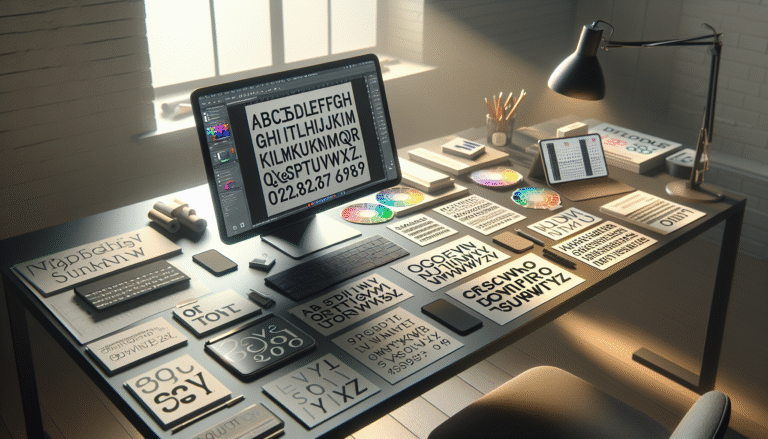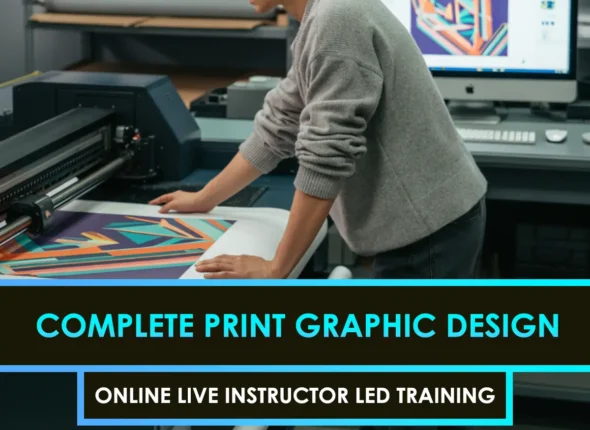Importance of Font Selection For Branding
The Role of Fonts in Brand Identity
Fonts are like the secret sauce in a brand’s identity recipe. Pick the right font, and you’ve got the perfect way to showcase what a brand is all about. Fonts can convey professionalism or creativity, depending on the ones used. They aren’t just aesthetic design choices, but are also loaded with the power to shape how people think and feel about a brand. Imagine using a sharp sans-serif font to convey innovation or a fun script to evoke a “we’re cool and friendly” vibe. So yeah, fonts pack a lot of punch in shaping those first impressions.
If fonts boggle your mind, a peek at typography basics for graphic designers could be a good place to start.
Impact of Font Selection on Brand Perception
Do not underestimate the power of font choice in creating that all-important first impression. Get it right, and a font makes things easy on the eyes, stamps the brand in people’s minds, and builds a bridge of trust with them. But a font mismatch? This can complicate the message and convey the wrong signals.
Let’s break it down with a quick look at what different font types can suggest:
| Font Type | What They Say |
|---|---|
| Serif | Old-school, Trustworthy, Stately |
| Sans-serif | Fresh, Simple, Professional |
| Script | Fancy, Artsy, Down-to-earth |
| Display | Loud, Unique, Attention-grabbing |
Remember, brands need fonts that match their soul and speak to the folks they’re trying to reach. If there’s a clash, such as choosing a wild display font when aiming for a formal and serious message, the whole message could go up in flames. Say a bank wants to feel solid and safe, they’d probably reach for a serif font. Meanwhile, a new app ready to showcase its cutting-edge tech might opt for a sans-serif font for a modern edge.
And hey, fonts have to be crystal clear wherever they appear. If they’re a mess on screens or paper, readability suffers. Want to steer clear of common slip-ups in typography? Our article on typography mistakes to avoid may be helpful.
So, in picking fonts, remember they’re more than letters. They’re a loudspeaker for the brand’s voice, echoing in the hearts of the audience. For some cool ideas and what’s trending in the font world, take a gander at typography inspiration 2025.
Understanding Font Basics
Getting a grip on typography’s fundamentals is crucial for selecting fonts that make your brand stand out. Here’s a down-to-earth guide to help steer your font picks.
Typeface vs. Font
Many people confuse “typeface” and “font,” but they’re not the same. A typeface is the overall design of the letters, encompassing their appearance and texture. A font refers to the specific application of a typeface, including variations in size and weight.
| What it is | What it means | Example |
|---|---|---|
| Typeface | Design of letters | Arial |
| Font | Specific size and weight of a typeface | Arial Bold 12pt |
Want more juicy details? Check out our piece on typography basics for graphic designers.
Serif, Sans-serif, and Script Fonts
Fonts come in all shapes and sizes, each bringing its vibe.
- Serif Fonts: These guys have little feet at the end of the letters. They’ve got that vintage vibe and are often featured in print.
- Sans-serif Fonts: No feet here! These fonts are all about a clean, modern look and are the go-to choice for digital content.
- Script Fonts: Like writing in cursive but fancier. Perfect for adding a touch of extra elegance or flair.
| Font Style | What It’s Like | Where You’ll See It |
|---|---|---|
| Serif | Vintage, classy | Print media, serious papers |
| Sans-serif | Slick, modern | Online stuff, apps |
| Script | Fancy, swoopy | Invitations, logos, special text |
Font Families and Pairing
Font families are like a group of fonts that share a similar style DNA. They come in regular, italic, bold, and bold italic.
| Font Family | Variations |
|---|---|
| Arial | Regular, Italic, Bold, Bold Italic |
| Times New Roman | Regular, Italic, Bold, Bold Italic |
Matching fonts together is a trick to make stuff look nicer and more organized. Mixing a serif for headlines with a sans-serif for the main text can make everything look sharp and snappy.
Try different combos until something clicks just right for your brand. Curious about what pairs well together? Visit our article on typography inspiration 2025.
Once you know these typography basics, you’re better equipped to pick fonts that make your brand stand out. This know-how lays the groundwork for building a strong, unforgettable brand look. Need a pointer on what not to do? See typography mistakes to avoid.
Factors to Consider in Font Selection
Picking the right fonts isn’t just about aesthetics. It’s about making sure your brand’s vibe and message come through loud and clear. Here’s the scoop on what to think about when you’re choosing fonts for your brand.
Brand Personality and Message
Fonts speak, and you want yours to say what your brand is all about. Different fonts communicate different vibes. Serif fonts evoke a classic and trustworthy feel, reminiscent of newspapers or old-school books. Sans-serif screams modern and sleek. Perfect for tech companies. Feeling fancy? Script fonts bring that touch of high-class elegance to the table.
| Brand Trait | Ideal Font Type |
|---|---|
| Classic | Serif |
| Trendy | Sans-serif |
| Fancy | Script |
| Fun | Display |
Nailing the right font means you’ve gotta know your brand inside out. Matching the fonts with your core values makes your brand memorable. Dive deep into your brand’s personality before you settle on your font family.
Readability and Legibility
No one wants to squint at your text. Make it easy to read, wherever it shows up. Readability is about how easily people can zip through the text, while legibility is all about spotting individual letters and figures.
| Font Characteristic | Helps with Reading? | Helps with Seeing Letters? |
|---|---|---|
| Font Size | Big boost | Medium boost |
| Space Between Lines | Medium boost | Low boost |
| Space Between Letters | Medium boost | Big boost |
| Style (e.g., Bold, Italic) | Medium | Low |
Choose a font that’s clear on paper and a computer screen. You want people to get the message without eye strain. For anti-typography blunders, check out our typography mistakes to avoid.
Scalability and Adaptability
Your fonts need to work everywhere, from billboards to business cards. Flexibility is key, especially for logos. Whether it’s used in jumbo size or shrunk down, your font should remain readable. Additionally, it should look good in all media, including print and web.
A flexible font ensures a consistent, sharp, and professional appearance throughout. Your brand remains solid. If you’re into the nitty-gritty of fonts on digital platforms, have a peek at advanced typography for UI UX.
These considerations help shape a solid font choice for branding. Pay attention to your brand’s personality, readability, and versatility. Select fonts that enhance a unified and strong brand image.
Types of Fonts for Branding
Picking fonts wisely for branding? That’s like choosing the perfect outfit for your brand’s party. Wise font choices help your content look top-notch and easy to read. Let’s break down the big players in the font game: display, body text, and complementary fonts.
Display Fonts
Zap! Bam! Pow! Display fonts are like the superheroes of the font universe. Flashy, bold, and kinda loud, they tickle your eyeballs and draw folks in. Great for headlines, titles, and logos, but use them sparingly. Too many zaps in one go and it’s a bit of a razzle-dazzle overload.
| Usage | Examples |
|---|---|
| Headlines | Eye-catching Titles |
| Logos | Snazzy Brand Names |
| Packaging | Funky Labels, Eye-popping Signs |
Body Text Fonts
Think of body text fonts as the comfy sofa on which your words lounge. They have to be clear and cozy for those long reads, like articles or chapters. Serif fonts feature a slight flair on their edges, making them well-suited for printed materials. Sans-serif fonts skip the fancy bits and give you a sleek and modern feel, perfect for digital clock-watchers.
| Font Type | Best For |
|---|---|
| Serif | Print Stuff, Like Books |
| Sans-serif | Websites, Handy Apps |
Complementary Fonts
These are your trusty sidekicks. Complementary fonts add spice and variety to your main act. You’ll catch them hanging around subheadings, captions, and other text bits. Choose ones that get along just fine with the main fonts, so they don’t start a scuffle on the page.
A solid pairing glides the reader through the content, smooth as a hot knife through butter.
| Usage | Examples |
|---|---|
| Subheadings | Handy Section Titles |
| Captions | Picture Tunes, Tiny Footnotes |
| Quotes | Wise Words, Customer Love Notes |
Understanding how each font type stands out in branding is the key to effective design. Wanna dig deeper into typography tips? Check out our handy guide on typography basics for graphic designers. Additionally, maintain a professional appearance by avoiding these common typography mistakes.
Implementing Fonts in Branding
Choosing the right fonts is crucial for shaping a brand’s image. Fonts convey a brand’s essence in subtle or bold ways. Whether it’s for logos or advertisements, the right typeface is like pairing the perfect shoes with an outfit—it enhances the overall look.
Logo Design and Typography
Typography isn’t just about letters; it’s part of a brand’s heartbeat, especially in logos. Choose fonts that speak to what the brand is all about. A solid logo blends a cool typeface with style and flair, ensuring it sticks in people’s minds. And, it’s gotta look good, small or big, on a business card or a billboard.
| Game Plan | What to Keep in Mind |
|---|---|
| Picking Fonts | They should scream, “That’s our brand!” |
| Size Flexibility | Gotta be clear from tiny to huge |
| Standing Out | Unique enough to be remembered |
Brand Guidelines and Consistency
Think of brand guidelines as the rulebook for all things visual, including fonts. They’ve got to lay down the law on:
- Which fonts are the main characters, and which are backup singers
- Sizes and spacing (a little space can be a big deal)
- Dos and Don’ts for Using Fonts in Headers, Text, and Other Elements
Sticking to these rules means people will recognize the brand from a mile away. Guidelines should be clear but not strict, allowing some room for creativity.
Incorporating Fonts in Marketing Collateral
Using the chosen fonts in all marketing stuff is like passing that final group project. Everything matches. This includes:
- Pamphlets
- Websites
- Social media posts
- Ads
Whatever the medium, following the font guidelines ensures that everything looks consistent and cohesive, as if it came from the same excellent brand. When it comes to print or screens, readability is king.
| Material | Font Size (pt) | What it Does |
|---|---|---|
| Pamphlet Headers | 24-30 | Grabs eyes, keeps ’em |
| Website Text | 14-16 | Easy-breezy reading |
| Social Media Text | 18-22 | Quick to read, leaves an impression |
For a shot of creativity, peek into typography inspiration 2025.
Choosing and playing with fonts isn’t just an art; it’s a strategy. Focus on crafting that standout look from the logo through to every magazine ad and Facebook post, and avoid typical snafus. Catch our guide on typography mistakes to avoid.
Tips for Effective Font Selection
Picking the right font isn’t just an art; it’s a vital piece in building a strong brand vibe. Here’s how to nail it.
Conducting Font Research
Starting with some font research is an innovative approach. Please familiarize yourself with the various font types, their unique characteristics, and how they represent your brand.
Explore various font families and pairings to find those that align with your brand’s identity. Browse through font databases and libraries to identify styles that truly reflect your brand’s personality. Take notes on your discoveries and create mood boards to visualize how these fonts work in practical situations.
| Font Type | Traits | Best For |
|---|---|---|
| Serif | Classic, Posh | High-End Brands, Magazines |
| Sans-serif | Sleek, Simple | Techies, New Kids on the Block |
| Script | Fancy, Artsy | Fashionistas, Creatives |
Testing Fonts Across Platforms
Now that you have a list of fonts to test, evaluate them across every platform you can think of. This step is crucial for ensuring that they adapt seamlessly and maintain a professional appearance wherever they are used.
Try out the fonts on various platforms, including websites, apps, Instagram stories, and even traditional print materials. Check how they perform when resized. Do they stretch or shrink while retaining their visual appeal? This process will help you ensure that your font choices enhance your brand’s presence consistently across all media.
| Platform | How It Looks |
|---|---|
| Website | Superb |
| Mobile App | So-So |
| Print Material | Fantastic |
| Social Media | Decent |
Seeking Feedback and Revising Accordingly
Get feedback directly from your team, including designers, marketers, and even your fans. They can provide valuable insights on what works and what doesn’t when it comes to your preferred fonts.
Use their feedback to make adjustments. You may need to adjust the size, weight, or even select a new font entirely. Experiment until the font feels like a natural extension of your brand.
Keep a record of your final selections and the dos and don’ts in your brand playbook for everyone to follow. To maintain consistency in your font choices, refer to our article on typographical rules for success.
These guidelines will help you select a font that is not only visually appealing but also effective in making your brand stand out. For additional inspiration, check out our 2025 font trends page.
FAQS – Frequently Asked Questions
Font selection for branding is the process of choosing typefaces that visually represent a brand’s personality, tone, and values.
Fonts influence how audiences perceive your brand. The right typeface builds trust, enhances recognition, and conveys your brand’s identity instantly.
Start by identifying your brand's tone (modern, playful, serious, etc.), then choose a font that aligns with that voice. Test for readability and consistency.
A combination of 2–3 fonts (primary, secondary, and accent) is ideal. It helps build hierarchy while maintaining visual consistency across platforms.
Serif Fonts: Trustworthy, traditional brands
Sans-Serif Fonts: Modern, clean brands
Script/Display Fonts: Creative, expressive brands
Yes, many free fonts from Google Fonts or Font Squirrel are suitable for branding. but always check the license for commercial use.
Using too many fonts, choosing unreadable typefaces, ignoring brand tone, or using trendy fonts that don’t age well are common errors.
Typography creates a visual voice for your brand. It can convey sophistication, energy, minimalism, or heritage. shaping how users feel about your brand.
Use contrast: pair a bold display font with a clean sans-serif typeface, or a serif typeface with a sans-serif one. Maintain balance, legibility, and brand alignment.
Yes. Consistency in font use builds brand recognition and professionalism across websites, ads, packaging, and social media.













